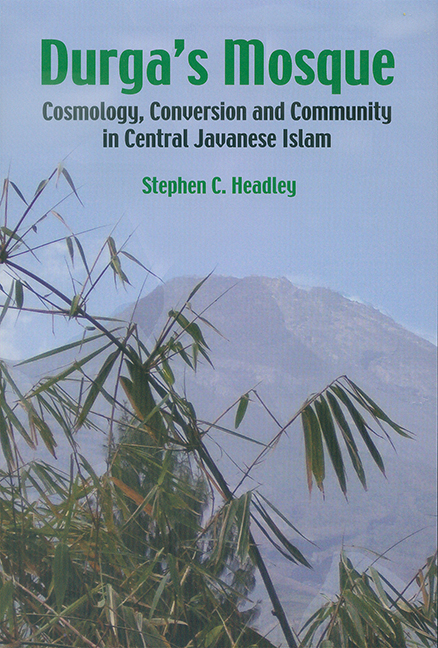Book contents
- Frontmatter
- Contents
- List of Figures
- List of Tables
- Preface
- Acknowledgements
- Introduction: Cosmology, Conversion and Community in Javanese Islam
- PART I THE SOCIOLOGY AND PRACTICE OF RELIGION IN CENTRAL JAVA
- PART II RECONSTRUCTION OF LOCAL RELIGIOUS HISTORY
- 5 Village Muslim Lineages: Local Genealogies in the Forest “Guardian of Death”
- 6 Village Maps for Royal Lineages: Paku Buwana VI in Durga's Forest
- PART III INVOKING THE COSMOS, MAGNIFYING ALLAH: STRUCTURING A LANDSCAPE IN THE SEVENTEENTH TO NINETEENTH CENTURIES
- PART IV COSMOLOGY, CONVERSION AND COMMUNITY IN CENTRAL JAVANESE ISLAM TODAY
- Bibliography
- Index
- About the Author
6 - Village Maps for Royal Lineages: Paku Buwana VI in Durga's Forest
from PART II - RECONSTRUCTION OF LOCAL RELIGIOUS HISTORY
Published online by Cambridge University Press: 21 October 2015
- Frontmatter
- Contents
- List of Figures
- List of Tables
- Preface
- Acknowledgements
- Introduction: Cosmology, Conversion and Community in Javanese Islam
- PART I THE SOCIOLOGY AND PRACTICE OF RELIGION IN CENTRAL JAVA
- PART II RECONSTRUCTION OF LOCAL RELIGIOUS HISTORY
- 5 Village Muslim Lineages: Local Genealogies in the Forest “Guardian of Death”
- 6 Village Maps for Royal Lineages: Paku Buwana VI in Durga's Forest
- PART III INVOKING THE COSMOS, MAGNIFYING ALLAH: STRUCTURING A LANDSCAPE IN THE SEVENTEENTH TO NINETEENTH CENTURIES
- PART IV COSMOLOGY, CONVERSION AND COMMUNITY IN CENTRAL JAVANESE ISLAM TODAY
- Bibliography
- Index
- About the Author
Summary
In Chapter 4 on the deterritorialization of the Javanese village communities it was shown that the Javanese village headman, the bekel, was first and foremost a tax farmer and that his role was often in blatant contradiction to the territorial integrity of the village (Elson 1997, pp. 28–30). To begin with, the function of tax farmer was usually bought. Where the village settlement was at a certain distance from the palace administration, the bekel and his followers could develop their common interests at the margin of the stratified centralization of the divine right rice agriculture. As discussed in Chapter 3, between the village cults and the royal cults there existed a massive gap that was sometimes filled by regional cults, although these always risked royal censure. The appearance of a supra-village sphere often took the form of networks animated by lineages. These “new” genealogies manifested the partial marginalization of communities based on the “sharing” of a common village space, and the deployment of worship communities in a patchwork of kin-based networks whose activities could lie dormant for shorter or longer periods of time.
Javanese religious praxis in local territorial communities such as the village or the urban quartier (cf. Chapter 13) mostly involves either mosquebased worship or family life passage events with prayer meals (slametan) organized at a home, which then serves as the site of the invocations. It is also possible, however, for a person to go away, alone or with his family, on a pilgrimage, to pray at a particular shrine in the mountains or on the tomb of a king or Muslim saint in the valleys. Leaving Java aside, throughout western Austronesia, a third praxis which is not rooted in a place, such as a mosque or a household, takes as its focus kinship ties in the form of lineages worship communities. In Java, these cults are usually voluntary associations. In Part II we are describing two lineages, one aristocratic and the other Muslim, each one constituting a community of worship “centred” in the Kaliasa region. While their centre is territorial, their members are scattered. Each of these lineages also represented an historical stage in the development of individuation in the Javanese social morphology.
- Type
- Chapter
- Information
- Durga's MosqueCosmology, Conversion and Community in Central Javanese Islam, pp. 226 - 248Publisher: ISEAS–Yusof Ishak InstitutePrint publication year: 2004



